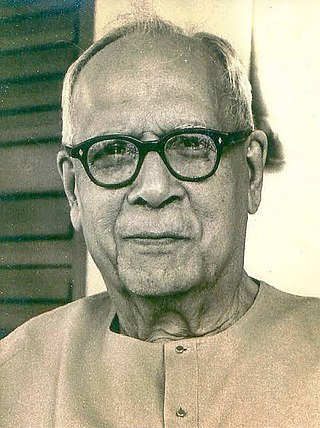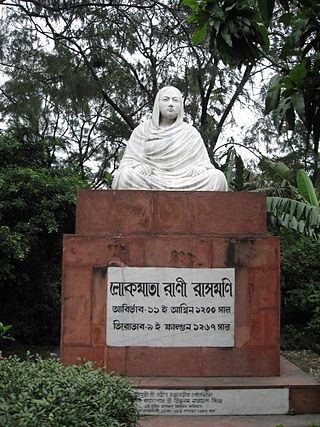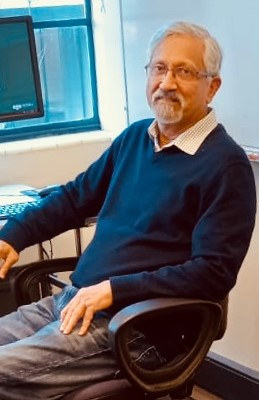
Syama Prasad Mukherjee was an Indian politician, barrister and academician, who served as India's first Minister for Industry and Supply in Jawaharlal Nehru's cabinet. After falling out with Nehru, protesting against the Liaquat-Nehru Pact, Mukherjee resigned from Nehru's cabinet. With the help of the Rashtriya Swayamsevak Sangh, he founded the Bharatiya Jana Sangh, the predecessor to the Bharatiya Janata Party, in 1951.

Bipin Chandra Pal was an Indian nationalist, writer, orator, social reformer and Indian independence movement freedom fighter. He was one third of the "Lal Bal Pal" trio. He was one of the main architects of the Swadeshi movement. He is known as the Father of Revolutionary Thoughts in India. He also opposed the partition of Bengal by the British colonial government.
The Subaltern Studies Group (SSG) or Subaltern Studies Collective is a group of South Asian scholars interested in the postcolonial and post-imperial societies. The term Subaltern Studies is sometimes also applied more broadly to others who share many of their views and they are often considered to be "exemplary of postcolonial studies" and as one of the most influential movements in the field. Their anti-essentialist approach is one of history from below, focused more on what happens among the masses at the base levels of society than among the elite.

The Swadeshi movement was a self-sufficiency movement that was part of the Indian independence movement and contributed to the development of Indian nationalism. Before the BML Government's decision for the partition of Bengal was made public in December 1903, there was a lot of growing discontentment among the Indians. In response the Swadeshi movement was formally started from Town Hall at Calcutta on 7 August 1905 to curb foreign goods by relying on domestic production. Mahatma Gandhi described it as the soul of swaraj (self-rule). The movement took its vast size and shape after rich Indians donated money and land dedicated to Khadi and Gramodyog societies which started cloth production in every household. It also included other village industries so as to make village self-sufficient and self-reliant. The Indian National Congress used this movement as arsenal for its freedom struggle and ultimately on 15 August 1947, a hand-spun Khadi tricolor Ashoka Chakra Indian flag was unfurled at Princess Park near India Gate, New Delhi by Jawaharlal Nehru.

Ishwar Chandra Bandyopadhyay CIE, popularly known as Ishwar Chandra Vidyasagar, was an Indian educator and social reformer of the nineteenth century. His efforts to simplify and modernise Bengali prose were significant. He also rationalised and simplified the Bengali alphabet and type, which had remained unchanged since Charles Wilkins and Panchanan Karmakar had cut the first (wooden) Bengali type in 1780.

The Bengal Renaissance, also known as the Bengali Renaissance, was a cultural, social, intellectual, and artistic movement that took place in the Bengal region of the British Raj, from the late 18th century to the early 20th century. Historians have traced the beginnings of the movement to the victory of the British East India Company at the 1757 Battle of Plassey, as well as the works of reformer Raja Rammohan Roy, considered the "Father of the Bengal Renaissance," born in 1772. Nitish Sengupta stated that the movement "can be said to have … ended with Rabindranath Tagore," Asia's first Nobel laureate.

Ramesh Chandra Majumdar was a historian and professor of Indian history. Majumdar is a noted historian of modern India. He was a former Sheriff of Kolkata.
Tanika Sarkar is a historian of modern India based at the Jawaharlal Nehru University. Sarkar's work focuses on the intersections of religion, gender, and politics in both colonial and postcolonial South Asia, in particular on women and the Hindu Right.

Sir Jadunath Sarkar, was a prominent Indian historian and a specialist on the Mughal dynasty.

Swapan Dasgupta is an Indian journalist and politician. He is influential within the Indian right wing, writing columns for leading English dailies espousing Indian nationalism. He is a nominated member of the Rajya Sabha. In 2015, Dasgupta was conferred with the Padma Bhushan for his contribution to literature and education.

Anushilan Samiti was an Indian fitness club, which was actually used as an underground society for anti-British revolutionaries. In the first quarter of the 20th century it supported revolutionary violence as the means for ending British rule in India. The organisation arose from a conglomeration of local youth groups and gyms (akhara) in Bengal in 1902. It had two prominent, somewhat independent, arms in East and West Bengal, Dhaka Anushilan Samiti, and the Jugantar group.

Mahishya, also spelled Mahisya, is a Bengali Hindu traditionally agrarian caste, and formed the largest caste in undivided Bengal. Mahisyas were, and are, extremely diverse Bengali caste counting among themselves all possible classes in terms of material conditions and ranks.
Barun De was an Indian historian. He served as the first professor of social and economic history of the Indian Institute of Management, Calcutta, founder-director of the Centre for Studies in Social Sciences, Calcutta and the Maulana Abul Kalam Azad Institute of Asian Studies, Kolkata and as the honorary state editor for the West Bengal District Gazetteers. He was chairman of the West Bengal Heritage Commission.

Sir Frederick James Halliday was a British civil servant and the first Lieutenant-Governor of Bengal.
Susobhan Chandra Sarkar (1900–1982) was an Indian historian.

Amiya Prosad Sen is a historian with an interest in the intellectual and cultural history of modern India. Currently he is Sivadasani Fellow at the Oxford Centre for Hindu Studies, Oxford (UK). He was previously the Heinrich Zimmer Chair at the South Asia Institute, Heidelberg University. He has served as Professor of Modern Indian History at Jamia Millia Islamia, New Delhi. He has been Agatha Harrison Fellow to the University of Oxford and Visiting Fellow to the Indian Institute of Advanced Study, Shimla, and the Centre for Contemporary Studies, Nehru Memorial Museum & Library, New Delhi. During 2007–08, he was Tagore professor at Vishwa Bharati, Shantiniketan.

Krishna Kumar Mitra (1852–1936) was an Indian freedom fighter, journalist and leader of the Brahmo Samaj. He is remembered for his contributions to the Swadeshi movement through his journal Sanjibani.
The Mahila Atma Raksha Samiti was a women's movement in Bengal, India. MARS was a mass organisation linked to the Communist Party of India.

Mridula Mukherjee is an Indian historian known for her work on the role of peasants in the Indian independence movement. She is an ex-chairperson of the Centre for Historical Studies at the Jawaharlal Nehru University, Delhi, and former director of the Nehru Memorial Museum and Library.

Sekhar Bandyopadhyay is an Indian historian and a Fellow of the Royal Society Te Apārangi. Bandyopadhyay is known for his research on the Dalit caste of Bengal.














